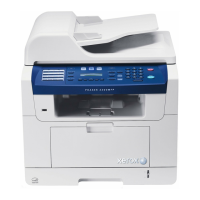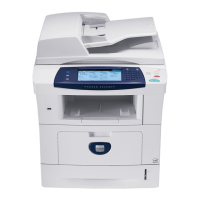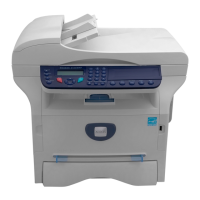2-28 Phaser 3300MFP Service Manual
Theory of Operation
SMPS & HVPS board
The SMPS supplies DC Power to the System. It takes 110 V/220 V and
outputs the +5 V, +24 V to supply the power to the Control Board.
The HVPS board creates the high voltage of THV/MHV/Supply/Dev and
supplies it to the print cartridge for making best condition to display the image.
The HVPS takes the 24 V and outputs the high voltage for THV/MHV/BIAS,
and the high voltage output is supplied to the toner, OPC cartridge, and
transfer roller.
1) HVPS (High Voltage Power Supply)
■ Transfer High Voltage (THV+)
■ Input Voltage: 24 V DC ± 15%
■ Output Voltage: MAX +5.0 KV ± 5%, (Duty Variable, no loading)
-> 1.2 KV ± 15% (when cleaning, 200 ΜΩ)
■ Output Voltage Trigger: 6.5
μ
Α
■ Input contrast of the Voltage stability degree: under ± 5% (fluctuating
input 21.6 V - 26.4 V) Loading contrast: ± 5% or less
■ Output Voltage Rising Time: 100 ms Max
■ Output Voltage Falling Time: 100 ms Max
■ Fluctuating transfer voltage with environmental various: +650 V (Duty
10%) ~ 5 KV (Duty 90%)
■ Environment Recognition Control Method: The THV-PWM ACTIVE is
transfer active signal. It detects the resistance by recognizing the
voltage value, F/B, while permits the environmental recognition
voltage.
■ Output Voltage Control Method: Transfer Output Voltage is outputted
and controlled by changing Duty of THVPWM Signal. 10% Duty: +650
V, 90% Duty: +5 KV ± 5%
■ Charge Voltage (MHV)
■ Input Voltage: 24 V DC ± 15%
■ Output Voltage: -1.3 KV ~ -1.8 KV DC ± 50 V
■ Output Voltage Rising Time: 50 ms Max
■ Output Voltage Falling Time: 50 ms Max
■ Output Loading range: 30 ΜΩ ~ 1000 ΜΩ
■ Output Control Signal (MHV-PWM): CPU is HV output when PWM is
Low
■ Cleaning Voltage (THV-)
■ The (+) Transfer Voltage is not outputted because the THV PWM is
controlled with high.
■ The (-) Transfer Voltage is outputted because the THV-Enable Signal
is controlled with low.
■ The output fluctuation range is big because there is no Feedback
control.
■ Developing Voltage (DEV)

